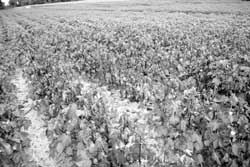Cotton And Lightning
JACKSON, TENN.
I have visited several fields in the past few weeks to examine
circular /slightly irregular areas characterized by wilt, severe
necrosis and death. After visiting with several other specialists, it is
our consensus that these injured areas were caused by lightning.
Although no action can be taken to bring injured plants out of the
stress, additional information on plant symptoms may help you properly
diagnose the stress and reduce the amount of ‘flak’ directed at your
sprayer operator.
Several strong storms have made their way through the area over the
past month, but I think much of the damage I’ve seen was caused by a
system that moved through 14 July 2014. I’m certain the system which
moved through late last week and into the past weekend also damaged a
few areas, as did systems that moved through on the 23rd of July.
Although this isn’t an issue many cotton producers in the western states
experience, lightning is very much a part of our afternoon, pop-up
thunderstorms.
Individual plant injury characteristics and shape of the affected
area can vary substantially and are a function of a number of factors,
including surface and subsurface soil moisture contents, strength of
bolt, and plant biomass, among other things. Without delving too far
into the physics of the strike, the large concentration of
ion-containing water in the cotton stalk makes a far-better conductor
than the lower-water content soil. Subsequently, the strike passes
through the plant to ground the negative charge. As the negative bolt
approaches the plants, streamers, or positive electric channels, form
through plants near the negative bolt. This transfer of charge, through
several different mechanisms, disrupts cell membranes and causes cell
death.
So how does this affect the plant, and what does it look like?

A number of observations can guide you to diagnosing injury from
lightning. First, the affected area will generally encompass an area
less than 50’ in diameter. Although the affected area generally
resembles a circle, these areas can be misshapen as a function of the
factors mentioned above. Typically wilt will occur very rapidly with the
plants in the center of the region being most affected.
Immature areas of each plant are generally the first to show signs of
injury and are often dead within days. The apical meristem (plant apex)
of almost all affected plants will die very quickly and the stem
immediately below the growing point may be twisted or hooked so severely
the meristem may be pointing towards the ground. Some affected plants
may remain alive but commonly express symptoms of a severe abiotic
stress (boll shed, leaf reddening, wilt). Damaged vascular tissue will
appear brown. ‘Blow out’, or a vertical lesion or scarring, may be noted
roughly 5-6 nodes down from the meristem and encompass several
internodes. As previously mentioned, these symptoms do vary
substantially from strike-to-strike.
Although there is no method to save these injured plants, these areas
should serve as testaments to the potential dangers of lightning. This
is of particular importance now that chopping crews have again become a
fairly common method of combatting weeds. ∆
DR. TYSON RAPER: Cotton & Small Grains Specialist, University of Tennessee